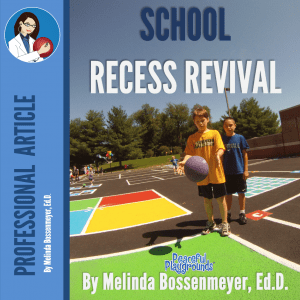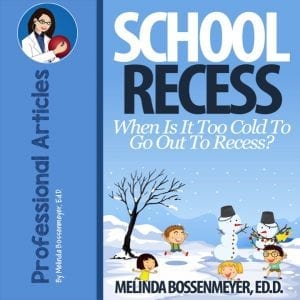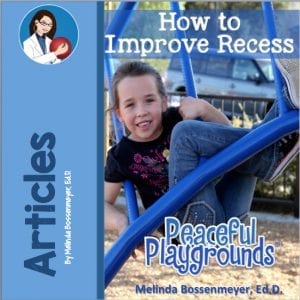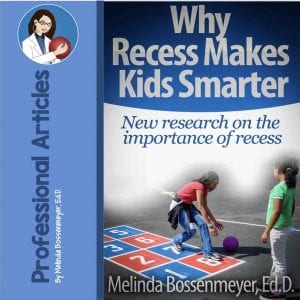Bullying Prevention: Life's Lessons in Good and Evil
by Dr. Melinda Bossenmeyer, The Recess Doctor

Bullying Prevention
Good vs Evil in Schools
As you may know, last month I attended a gathering of like minded individuals called Hero Camp. During the Hero Camp discussions, I kept reflecting on how school mirrors society and schools are a laboratory for life's lessons. In particular, school campus provides us the microcosm of "evil", played out as bullying, versus "good", which manifests in those students who take a stand against bullying.
"The only thing necessary for evil to triumph is for good men to do nothing." British Statesman, Edmund Burke
Hero Camp
First, allow me to give you a little background on the Hero Camp. I didn't know fully what I was getting myself into but found the concept of "Hero Camp" intriguing. The gathering was based on Phil Zimbardo's work and his research on good and evil. His most recent book is called, The Lucifer Effect , and its central theme is an exploration of how good people can turn evil.
Professor Zimbardo is perhaps best known for his early research project called the "Stanford Prison Experiment" where he studied well adjusted typical college students' reaction and coping skills exhibited in the prison setting in which 1/2 the students' were guards and 1/2 were prisoners.
Professor Philip Zimbardo
You may remember the experiment had to be called off less than a week into the experiment due to the cruelty of the guards and resulting mental instability of the prisoners.
One observing or reading about the experiment would have to admit the good students, given the right circumstances, turned evil. Likewise in the not too distant past, most Americans can remember the Abu Ghraib prisoner abuses in Iraq. When faced with what most people would consider undesirable and un-American behavior at Abu Ghraib, I pause and wonder with my retired principal and teacher hat if there is anything we – "school educators" – should have and could be doing to instruct students to consider

Wondering down the path of evil
Now, let's consider the definition of evil according to Dr. Zimbardo.
"Evil is the exercise of the power to intentionally harm, hurt, destroy or commit crimes against humanity."
The Road To Evil, he points out, is a slippery slope. One of the most intriguing concepts to me was that evil is often times not premeditated. It is the mindless taking of the first step to dehumanizing others, and the de-individualization of self (Anonymity) leading to the lack of personal responsibility coupled with the blind obedience to authority. As a result, individuals become uncritical and conform to group norms. Individuals or groups who are passively tolerant give rise to evil through inaction or indifference. This results in the perpetuation of evil.

Playgrounds: the perfect laboratory for Life Lessons
You may be wondering what this has to do with schooling? As educators, we are called to insert "life lessons" into schooling. It struck me that we have an opportunity each day to teach the lesson of good action vs. evil action in school bullying situations. Bullying in schools is one of the most prevalent problems facing schools today. Yet bullying intervention programs have largely failed and it is fair to say, miserably.
A 2004 comprehensive evaluation of the effectiveness of anti-bullying programs in schools around the world (Bullying in Schools: How Successful Can Interventions Be? edited by Peter K. Smith, Debra Pepler, and Ken Rigby) found that achievements so far have been modest at best. In some cases, the interventions have been totally unsuccessful.
Why have anti-bullying program met with so little success? They suggest two important reasons.
1. The first is that educators have focused on immediate strong disciplinary action when bullying was observed. Unfortunately, the problem with this approach is that the research indicates that bullying rarely occurs in front of adults. Instead bullying occurs in the company of children. Children observe bullying. Teachers do not. Bullying research also indicates that only occasionally do students report bullying.
2. The second reason why anti-bullying programs often fail (Smith, Pepler and Rigby) is because they do not effectively engage children in the elimination of bullying. One of the startling facts to emerge from the research into children's bullying behavior in recent years has been to document that it occurs in the presence of other children. Unlike previous thinking, we can no longer conceive of bullying at school as a covert activity, engaged in guiltily when there is no one around. On the contrary, research has found that school bullies glory in the presence of an audience. It provides theater. To a remarkable extent, the watchers either enjoy the spectacle or watch in a curious but largely disengaged manner. The few who may object are in a small minority.
Let's flash back for a moment to Dr. Zimbardo's work on good and evil. He points out "The only thing necessary for evil to triumph is for good men to do nothing." British Statesman, Edmund Burke.
What Schools Can Do
If we accept the notion that the only thing necessary for evil to triumph is for good men to do nothing, then devising a curriculum against inaction and teaching children to think critically and act thoughtfully would be early training for righting the world of evil, right? And what better laboratory is available to us than the school playground complete with chronic episodes of bullying?
This opportunity to "practice" skills needed to take a stand against bullying is perhaps unequaled as bullying persists within the entire schooling experience from elementary to high school.
Why not use this opportunity to teach children, at an early age, of the evils of inaction? Both in Nazi Germany, or Abu Ghraib prison many people observed what was happening and did nothing. These situations point out that inaction and passively watching give tacit approval to continue with the abuses. It is the silent majority that makes evil deeds more accepted – we are aware that the acts are not acceptable, but because we do nothing, the acts are accepted.
Peaceful Playgrounds Recess Program Kit
Peaceful Playground Program Kit, Equipment Companion Package, Recess Roll Out Stencils, Instructional Games DVD Series, School Set Activity Guides, Stripping Machine, and Yellow Outlining Paint, (Adding color to game markings is optional and an additional purchase). Site License, Staff Webinar, and more…. Considered the standard in K-6 playground design.
"We recommend that you do not schedule a paint day until you receive all the materials at the school site or center. "

Bystanders hold the key to eliminating bullying
One of the most dramatic findings in bullying research is the focus on the bystander as an effective intervention strategy to reduce bullying. On those rare occasions when a witness does object to bullying, there is a good chance that the bullying will stop.
In fact, researchers have reported that bystander objections effectively discourage bullying at least half the time.
Heroism is the Antidote to Evil
The question becomes, if successful anti-bullying programs must engage the bystander, what skill set is necessary for the bystander to choose action over inaction?
Psychologists have identified this as pro-social behavior and altruism. Pro-social behavior benefits group members but also the individual engaging in that behavior, perhaps through higher esteem or greater acceptance by the group, or avoidance of social censure.
Altruism refers specifically to positive social behavior that would be done even without personal gain.
The motivating factor that separates these types of behavior is empathy. Research shows in experiments, in which people are asked to empathize with a fictional character in distress, they are more likely to help the person even if there were no negative consequences if they did nothing. Thus, if we strive to teach children to relate more with others, we may find they become more sensitive to their situation and act in more benevolent ways.
Professor Zimbardo points out that establishing pro-social behavior and promoting civic virtue highlights the potential positive aspects of social influence. Moral behavior can be cultivated in early life by rewarding positive behavior. Government, education, and social institutions can be re-designed to facilitate critical thinking and responsible conduct. We as educators can begin to teach these lessons as early as preschool. What methods are you as educators taking to pass this information along to your students?
Cultivating Everyday Heroes
To further cultivate this concept Professor Zimbardo and others have formed an organization called, Everyday Heroes. They promote the concept that heroism is the antidote to evil.
He proposes the development of the heroic imagination by creating an educational system that instills in every child the self-belief that, "I am a Hero-in-Waiting. I will act heroically when my time comes."
Does this sound interesting?
Stay tuned to learn more about in-school bullying prevention and how savvy administrators are capturing this moment of learning to instruct both victims and bystanders on bully prevention strategies.
Peaceful Playgrounds Program, a playground organizational program, already has incorporated a strong anti-bullying component. Every study in which Peaceful Playgrounds Program has conducted independent research, indicates a significant reduction in bullying behavior at schools which have fully implemented the Peaceful Playgrounds Program.
Tags: bullying, bullying prevention, discipline, school bullying






